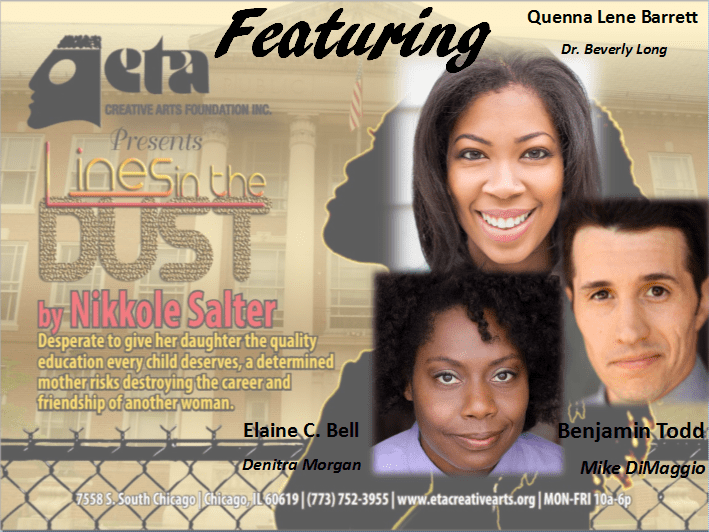It would be a disservice to relegate the play Lines in the Dust as a compulsory offering of social protest fiction and bandwagon outpour, seeking attention on entitlement that audiences passively care about its themes and subjects to indict structural racism in America. To applaud it on such terms demeans the work below its highest merit as an actor’s play; it simply uses race to occur. With it, theaters and audiences participate in and witness the basic tenets of live theater I have not seen so purely in quite some time before eta Creative Arts’ second production presenting season back-to-back works of Nikkole Salter. 
The play begins with two black women sitting together alone, first seen as relative class equals in sanctuary outside the urban center of Newark, New Jersey, where they share oppressed history within. Their opposing figure—a white man—enters to influence how and where the two black women will end the play sitting together alone once more, no longer equal but for their oppressive histories. Yet the white man is too systemically oppressed himself to solely blame for the women’s inevitable and excruciating shift.
Lines in the Dust comprises two-actor scene work through its over two hours length, with its three-person cast onstage together in only a single moment. In that brief flurry, one character’s prompt and prompted exit is necessary for the denouement the play drives toward. That exiting character is Denitra Morgan (Elaine C. Bell), a single black mother of a high school daughter she wants the best education for. Dr. Beverly Long (Quenna Lene Barrett) is the new interim principal of the daughter’s suburban New Jersey high school, a convenient placeholder as a woman and minority to oversee a high-achieving population. Dr. Long must hurry Denitra offstage to resume her defenses against haggling from Mike DiMaggio (Benjamin Todd), an independent private investigator of school residency fraud.

Mike’s goal is to convince Dr. Long, and ultimately the school board, to rid the exclusive enclosed community’s school of outside imposters who migrate there to better prepare and compete for higher education. His identity as an Italian-American from a tightknit working-class community fogs his vision of the American Dream as attainable by all but under surveillance by some. With this trio giving voice to communities and generations, audiences must stay with the actors to demystify how complicated residency obscuring, community protest strategies and many families’ fraudulent activities continually unfold.
Director Phyllis Griffin’s task is to build the play’s three-pronged class struggle from extended conversation always between two characters whose goals diverge quickly at start of every scene but the first. Their intense high stakes, uninterrupted communication is further complicated by one character’s questionable identity and another character’s double-agenting. Who are these people, really? The result is enjoyable, riveting leading performers pulling such scenes off. The story does not change the characters. The characters change the story. Each prolonged moment any two characters share pivots on a negotiation neither one ever manages a fully closed deal on, thus the story must go on.
Salter’s tricky writing choice is to give the full story with glaring absence of its most indispensable character: the child. I glanced quickly at the playbill to mistake an understudy as the cast member whose entrance I awaited eagerly as Denitra’s daughter Noelle, as her higher powers struggle to determine her fate; she never arrived onstage, but Noelle is such a critical character she remains enlivened in absentia in every scene of the play’s second act.
Noelle’s play I falsely anticipated would have been a disappointing and banal one. Not only would it have interrupted the script’s refreshing and tight dual scene partner structuring. But an actual child character would buffer just how much each adult character’s inner child is acting out upon the children they are supposed to serve; both Denitra and Dr. Long consider jeopardizing their children with possibility of each mother’s absence or commitment to an extra unplanned child. As Noelle’s mother, Bell’s misguided desperation is reminiscent of Viola Davis in the 2008 film version of John Patrick Shanley’s stage play Doubt. Her startling morph simulates a character’s death. Barret as Dr. Long and Todd as Mike fluctuate moment-to-moment in twists and crescendos akin to David Mamet’s unlikeable characters still loved despite it.
The majority of the play takes place in the principal’s office—a setting most people fondly remember as one childhood place they wanted no force to go. The play unfolds in this fitting penal environment where each adult in it will break the rules and the law, with justifications they strain to convince not only each other but themselves of. By the end, the usual suspects are the ones most punished.
Lines in the Dust exposes one little-known challenge Chicago Public Schools shares with those in many American metropolises, strained by laws to maintain segregation based beyond student work ethics and abilities—but race and class. African-American and lower socioeconomic families bear stereotype of adjusting or feigning primary addresses to win selective enrollment lotteries or better schools attendance. But suburban parents and families from higher socioeconomic backgrounds outside public school systems also take advantage of residency check loopholes to place children in the cities’ most elite schools.
Just as the main character driving Lines in the Dust is absent from her stage, the children subjected to the ongoing bureaucracy and absurd reforms wholly dependent upon guarding the elite remain oblivious, until their lives change or their changed futures arrive.
Lines in the Dust will play until March 28 at eta Creative Arts Foundation at 7558 S. Chicago Avenue. Performances at 8:00 on Friday and Saturday, Sundays at 3:00 p.m.
For more information and to purchase tickets, please visit Lines in the Dust at eta’s website.